Alguns procedimentos podem enfraquecer a auto avaliação do consultor
Incorporação de Processos
Problemas
Inadequada avaliação, de si próprio
Subtópico
Situação Efetiva
Características básicas de um consultor
Type in the name of the multiple-perspectives text.
Example: Bridge to Terabithia by Katherine Paterson
Características desconsiderando a ordem de importância
Conhecimento
Bagagem de conhecimento para realizar a otimização.
Habilidades
Jogo de cintura para otimizar os resultados dessas situações.
Comportamentais
Posicionamento nas situações planejadas ou impostas
Type in a relevant quote that highlights the character's point of view towards
Características desconsiderando a ordem de importância.
Try following a citation format: author's name, chapter, and page.
Example: 'Jesse drew the way some people drank whiskey. (...) Lord, he loved to draw. (...) When he was in first grade, he told his father that he wanted to be an artist when he grew up.' (Paterson, 2. 7)
Características para amplo debate e auto avaliação por parte do consultor, realizando algumas preparações anteriormente
Identify an important issue from the text that is being presented from different angles. Type it in.
Example: Jesse's drawing talent.
Repetir
A análise com debates e questionamentos, com outros consultores assim como executivos, clientes que conheçam sua atuação, afim de evitar uma auto avaliação inadequada, utópica e irreal.
Pontuar
Decide on the fourth point of view
Type in the name of the last character whose perspective on the issue you are going to present.
Example: Leslie Burke, Jesse's new next-door neighbor, and best friend.
Sua atuação perante elas
Point of view
Type in a relevant quote that highlights the character's point of view. Try to follow a citation format: author's name, chapter, and page.
Example: I can't get the poetry of the trees,' he said. She nodded. Don't worry,' she said. You will someday. He believed her.' (Paterson, 4. 24)
Estabelecer
Whose character does the third point of view belong to?
Type in his/her name.
Example: Mr. Aarons, Jesse's father.
Peso de importância para um dos aspectos específicos
What does the character think, say or do that suggests their perspective on the issue?
Type in a quote and try to maintain the citation format.
Example: 'He would like to show his drawings to his dad, but he didn't dare. (...) He'd thought his dad would be pleased. He wasn't. What are they teaching in that damn school? he had asked.' (Paterson, 2.8)
Efetuar
Decide on the second point of view
Name the character (it can either be the main character or one of the supporting characters) whose point of view you are presenting.
Example: Miss Edmunds, Jesse's music teacher.
Decomposições e complementações
Type in a quote that points out the character's position about the issue.
Try to follow a citation format: author's name, chapter, and page.
Example: 'She said he was unusually talented, and she hoped he wouldn't let anything discourage him.' (Paterson, 2. 8)
Analisar
Decide on the first point of view you are going to present.
Type in the name of the character (it can either be the main character or one of the supporting characters) whose point of view belongs to.
Example: Jesse Oliver Aarons, Jr., the main character of the novel, a fifth-grader living in a rural Southern area.
Cada Característica
Type in a relevant quote that highlights the character's point of view towards
Características para amplo debate e auto avaliação por parte do consultor, realizando algumas preparações anteriormente.
Try following a citation format: author's name, chapter, and page.
Example: 'Jesse drew the way some people drank whiskey. (...) Lord, he loved to draw. (...) When he was in first grade, he told his father that he wanted to be an artist when he grew up.' (Paterson, 2. 7)









